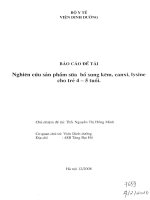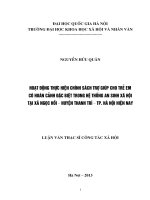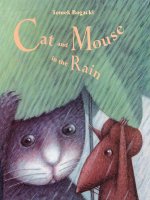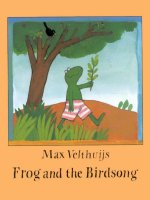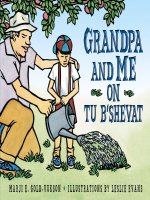Bộ sách “Oxford Read and Discover” cho trẻ em. Transportation then and now
Bạn đang xem bản rút gọn của tài liệu. Xem và tải ngay bản đầy đủ của tài liệu tại đây (25.63 MB, 30 trang )
Transportation
ThenandNow
JamesStyring
Readand discoverall abouttransportatlon
in the past and today ...
. What were the first planesmadeof?
. How fast can solar cars travel?
Readanddiscovermoreaboutthe worldl
provides
Thisseriesof non-fiction
readers
interesting
andeducationaI
content,wlth
activitiesandprojectwork.
SeriesEditor:HazeIGeatches
@RudioCDPackavaitabte
/ a nl8ou*?*',',
Coverphotograph:
RobertHardingWortdlmagery(Tranrrrrblrilrerl||xrlton fft|ldtr
ThenandNow
JamesStyring
3
lntroduction
4
1 ThenandNow
8
2 BoatsandShips
Buses,
3 Trains,
andTruckst2
16
4 Bicycles
andMotorcycles
20
5 Cars
24
6 Aircraft
28
7 Around
theWorld
32
8 ln the Future
36
Activities
52
Projects
54
Glossary
AboutReadand Discover 56
OXTORD
I ' N I V B R S I TY
PRESS
oxF()t{t)
t Nl\'tl(\tI)
t,ltliss
(;r eill (;li[(,n(l()| Stn.(.1.Oxli)r(l ()x2 6Dr
Oxli)r(l I lllversity l)rcss is it (leparlnrenl ot th(, University
o l Ox li rr(l. ll lirl llcrs l he t lrriv(rs ity s ()bje(1ive ()l cx(Tllcltc(,
irr rrserK h. schrl:rrshil), rn(l c(lU(ation by pul)lishing
worlclwick'in
Oxlor(l N('w Vlrk
Au(khn(l
(.rPr'lbwtr
l)rresSllililtr]
HongKong Karrchi
Kttrlir l.unrprrr N4rdri(l Mclbourne MexicoCity Nairobi
NewI)elhi Sh;rrghai liriPei Toronto
Wit h olliccs in
,\r!('ntina Ausrilr llrazil Chilc CzcchRepublic lialtce
(;ree(e Crrrlcutill;r Hungrry Italy
Japan Polan(l Poilugil
Sing.rporc Soulh Korca Switzerland lhailald Turkey
Ilkr.rir)c \riclnill
{)\l {)tt) itn(l ()xt,()RD I'NGt.tsH aue registered tfadc milrks
ol ( )\li)r(l [,nivcrsity Prcss in the UK iud in certain orher
( ( ) |nl ric\
t) O\l{)t(l []triversily Press 2o1o
I hf Dr{)rrl fights ol the author ltave bectr ilsscrted
I).rl.rl).rscriglrt Oxlord tJtrivcrsity llcss (Daker)
ljrst l)ul)lislre(l 2oIo
2()r-1 lot.l 2()12 2oll
l0()117654:]2
No rilrarrtlrorized
201o
A(;(NOWLtit)(;tiM tN I S
lllustrdfir)rJ/a,:Williitntl)iln{)ll{)(.1)l){,(rjl.Ik(,t),,)(slltl)sl:
Rebcccr Hnll\/l he ()rrirnisirli()n l)l):). (, ([]itl)1. I L lll: Kt,lly
Kcnnedy pP 19.2:l: l.rr l\4(x)res(;rirl)hi( \ l)l) 2.1.l(,,.1.1.,1(,:
Dusan Pavli( pP 36. :J8,.llt
'jltciltiriishorutlrlirris{)likr'lr)lirrrlIll,1111lnrrrrt/lrthcirkilrl
ldtriliJsion lr, ,1lrrr!il.f /rri'l,qrrrlrr\ rlrri rilir.r I r)l,u-irhl rkttctidl:
Action I)lus Sl)orls lnlirgos p l8 (Stcve l}Ir(lenshccutubent
bikc): AhDry pl) .1(S IlX.Kl()l.lo (D).5 (.lohn White Photos).
l0lllob llen|y), l"l ((; l' llowirrcr), I5(Nitrowlnlilges). 20
(lhe I'rint (irlk.ttor)..l:l (l\4oloritu l)i(1ure Library/Peel
P50),2tl {o lllyrn & (:lr('r'r'yAlexiln(ler l,hotography).29
(lSI' l'horogr'.rl)lry),:|0 (l,el(.r Ihrrirt). 3l (Carsten Leuzinger/
inrirg(l)r{)k( r/(l(}g), l5 lSinlon Holdcroft/jet pack): Corbis
pl) 2 I lllIr(r' l](.le(licl/IR NSIOcK/Bugatti], 33 (Kimimasa
M.ryiilDir)i (;(.lrv lnrrges pp 8 (KeystoncJStringer/Hulton
Ar(llivc/Kr)n l iki). I I (AfP). l2 (Hulton Archive). l3 (Chung
Sung lur)). l6 (lllllton Archive), 19 (Gettylutages), 27 (AIP/
Yv('s Rossyl: l\,liLrrten LIdema Photogrrphy p 8 (caDoe):NASA
lDr.rg(.sl)l) 27 (l)ile(hlusl,34; Oxford l,icture LibEly p 3t
((.hri\ An(lr('ws/l)uIt itrg): Oxfi)rd Universiry Press pp 3, 7, 9,
17. ll{ {lll\,lX).24.25.42: PA I'hotos p 35 (Segway); Skysails
(;nrbl | & (i). K(;. All rights rcseNed p 32: 'lbpForo p 2 I (The
(;r.rnr(.r (irllc( tionl.
is the movementof peopleor goods
Transportation
from one placeto another.We cantransportthingsin
the water,in the air,or overland.We canuseanimals,
vehicles,or just our feet.Sometimeswe travelfor
for vacationor just for fun.
work,andsometimes
Whattransportation
canyouseehere?
haveyouused?
Whattransportation
Whatothertransportation
do youknow?
photocopying
All rirhts rcscrvccl. No l)arl ol this p[blication may be
ft.prrrlrrr rtl, storc(l i n r retri('vill system, or transmitted,
rr ilny lolrD ()r l)y iny nrearrs. without the prior permission in
wrir ing r)l ( )xlirr(l tlniversity Il css, or as expressly pcrrtitted
by h!v, ()r lln(ler leInrs irgrecd with the appropriate
rcl)rognrl)ltics riglrts organizrlion. linquiries concerning
rePr(xllr(1ir)n outsi(lc tlre s(r)pe ol the above should be sent to
the LLl Righls I)('Pirrln)cnt. Oxli)r'(l Univcrsity Press, lt
the ilddrcss rl)ove
You must ltot circrrlilte this l)o{)k in iny other binding or
cover and you nust imPose this santc conclition rn nDv
acquirer
Atry websites refbrcd to iD this publi(iltion rre irr the
public domrin and their addresscs are prcvided by Oxlbr(l
[Jniversity Press for inlbn]ntion only. Oxfbr(l University Prcss
disclaims any rcsponsibility for thr, (r)utent
IstsN: 978 o 19 464499 o
Air Audio CD Prck containing this book and a CI) is illso rvilihl)lc
IsBN:971t o 19 464539 3
l ht'(ll) lr:rs.r (hoitc ol Arncricln irn
.\tt.t,, r'ttl|.1111'1111"\r
l'\,llY lIr)l( rs rrlro,rv,ril.rlrlc
l\lrN
')tB
llrr'. lr',1
\'
0
lil
llr .lr til"
r., l'rr [ 1, 1] , , 1
(1 , , , ilr , r , ,
(r
l' . r lr ' r
lt , lil, r . t t t lt r 1 l . i l l ( l
ll ilr.ril,rlt,
ow readanddiscover
moreabouttransportation!
,lt
Sleds were like rafts,
but they were used on
land. They were useful
becauseit's easierto
pull heavy things than
to lift them.
flhenandNow
Untilabout7,00Oyearsago,peoplehadto walk
Thentheystartedto useanimalsfor
everywhere.
later, peopleinventedvehicles.
transportation.
TheWheel
About 51500years ago, people
added wheels to sleds.Farmers
and traders made carts with
two or four wooden wheels.
Cows and horsespulled the
carts. Carts with wheels were
much faster than sleds.
Animals
People used horses and donkeys for transportation
in lots of places.People also used camelsin Africa,
elephantsin Asia, and llamas in South America.
Peoplestill use animals for transportation today.
TheFirstVehicles
People made rafts from tree trunks. They floated
on their rafts along rivers and on lakes.It was easier
than swimming, and they didn't get wet. These were
the first vehicles.
The wheel is one of the most important inventions
in history, and today you can seewheels everywhere.
Cars, buses,trucks, trains, bicycles,motorcycles,
and planes all have wheels.\il(rheelsare important
ln englnes, too.
A truckwith
a lot of trailersis
calleda roadtrain.
Thelongestroad
trainwasAustratian.
It had117trailers
with 2,126wheels!
r i ,ir-i,i trc nalT r ans por t ati o n
Until about 10,000 years ago, people lived in small
family groups and they didn't travel a lot. Then, as
villagesand towns became bigger, people had to travel
to find food. Peopleused animals to carry goods like
meat and fur.
Today
Transportation
Then about 61000years ago, people started to travel
long distancesto trade metals, salt, and spices.Ships
began trading in the Middle East 4,500 years ago.
People used ships becauseanimals could not travel
over water. Soon, people were trading all around
Europe and Asia.
Traders
tookChinese
sitkto Europe
atongthe
SitkRoad2,500years
ago.Theyusedhorses
andcamets
to carrythe
silkmorethan3,000kilometers.
Today, every country in the world useswater, air,
and land transportation to trade food, fuel, clothes,
and other goods like cars and televisions.
Tourists started to go on vacation by train and boat
200 years ago.From about 1960, with the invention of
large passengerplanes,tourism becamevery popular.
Today, about 900 million tourists travel to another
counffy every year.
In 2001, an American called Dennis Tito was the first
spacetourist. He flew in a Russianspaceshipto the
International SpaceStation. tVill tourists travel to
the moon one dav?
-rn Goto pages36-37 for activities.
,i;
ffi@@tumd
\
t
It
I
,$
.t
'
t
q
We useboatsandshipsto transportpassengers
and
freight.Boatsandshipscantravelalongriversand
acrosslakesandoceans.
Whatboatsor shipshave
you traveledonj
''t
i$
T
t
4
;{t-.''
rj
r' I
. .:lI
.{
$
'li
{
TheFix"st
S&:ips
Thw{:6rs*ffiq:uxts
The first vehicles that people used on water were rafts
made from tree trunks. Then more than 51000years
ago, people made canoes.They used paddles to power
their canoes.People still use canoestoday.
ln t947,ThorHeyerdaht
buitt
a raftsimilarto theancientrafts.He
saitedKon-Tiki
8,000kitometers
from
Peruto an islandin the PacificOcean.
i!i!r 1:1i
Egyptian traders sailed the first ships about 4,500
years ago on the River Nile. Later, the Ancient Greeks
sailed larger ships around the Mediterranean Sea.
Their ships were fast becausethey used sails,and at
the same time men rowed with oars.Traders sailed
between the Middle East and India in small ships with
triangular sails.Chinese,Korean, and Japanesetraders
had large ships with squaresails.
Chinese people invented the
compassabout 21000years
ago. Compassespoint to
north, and they help people
to sail in the right direction
acrossoceans.They are still
important for sailorstoday.
'l'lrc Vil<.ingslir.ed in Dcnmark,
Norlvav, and Su,cden
ru t ro L rIt. ( ) 0 0 v ea rs a g o .T l 're v sa i l e d ar ound Eur ope,
a n c l t h c l c r o s se dth e A tl a n ti c Oce a n to Canada. At
thc sumc time, hundrcds of ships \\'ere trading betu'een
. f ap a n ,I i o r c a , Ch i n a , a n d co u n tri e s in SoutheastAsia.
I iron r a b o u t 1 5 0 0 ' E u ro p ca n sh i p s s ailcclto Nor th
a n c l So u t l - rAr - r-rcri ca
A,fri ca , a n d A sia.' fhcir jour ncvs
s ()m c t i n t c st ( ) ok vca rs.A l o t o f sl -ri pssank clur ing
s t ()r l n s . ' l ' h cs hi p s \\'crc sma l l a r-rci
thc sailr lr s\\' cr c
brar,c. l)irates oftcr-tattackccl sl-ri1-ls
anci stole golcl
itncl silvcr.
A f t c r : l b o u t 1 8 0 0 , sh i p s b ccl rr-n ci mpor tant fir r
in t c r n a t i o n a l t r a d e i n g o o cl sl i kc co f- fbe)tca.,and spices.
Sl-ripsbecamc bigger, and thc1,'had a lot of sails to help
then-rso faster.
I
!'
,y
1
t,ut
li
*
rtr..j
Stcam cn gi r - r c spou'c r c c lm ( ) s t s l - r i psaftc r about 1850.
Stcam sh i ps hac l pr opc l l c r s anc i thc l '\\'c r c fi r s tc r tl - r an
sailing ships.Tirdav, wc makc modcrn sl'ripsfron-t
r - nctal,an d tl - r c i rc ngi nc s us e oi l or di es c l .J - hc r e ar e
about 35,000 c or r ul c r c i al s hi ps ar ounc l thc r .l or l d.
Freighters carrv fbod and clothes.,supcrtankers
tr anspor t oi l , and c r ui s e s hi ps c ar r \. pas s enger son
vacation. I(orea builds the most sl-rinsin the world.
nryui L
tQ'Zt-::S'*>
t;l( .-\"
- \r /
{
t
1
A.
'\
som es uper tank er s
ar eas lo ngas the tal tes t
KnockNevis
skyscrapers.
is 458 meter s[ong.
Saitor sus ebi c y c testo
tr aveIalongthe s hi p!
G o t o p a g e s3 8 - 3 9 f o r a c t i v i t i e s .
Transportation
becamemuchfasterafterthe
inventionof engines.
We usebusesto transport
peopleandgoods,trucksto transportfreight,and
trainsto transportpeopleandfreight.
In 1804, Richard Trevithick built the first train in
\Walesin the United I{ingdom. fts steam engine used
coal to heat water.The hot water made steam, and the
steam powered the engine.The train moved along two
metal tracks called a railroad. In 1825, the world's first
railroad systemopened in the United I(ngdom. Soon,
railroads with steam trains were common all around
the world. By 1930, steam trains could travel at about
150 kilometersper hour
.:,,,,.,:r:r"r,,.':,ii,':,,:.:
,,:
ln 1862 the first underground train systemopened
in London in the United ICngdom. Today, more than
160 cities around the world have underground trains.
Modern trains have electric motors or diesel engines.
Some long-distancetrains have restaurants,and
sleepercars with beds for passengersto sleepin. Trains
are good becausethey use lessfuel per passengerthan
cars,buses,or planes.Some high-speedtrains can
travel at more than 300 kilometers per hour.
ffi
".lQJ
rhe tongesttrain
--=-**{tt':.
Moscow
journeyin thewortd
The
is 9,288kilometers.
Trans-Si
berianExpress
takessixdaysto travel
from
acrossRussia,
Moscowto Vladivostok.
I*\
\-/
\
d
Vladivostok
Hnrses pulled the first buses 200 yearsago.Buses
becamepopular as citiesbecamebigger,because
people traveled on busesto get to work. Modern buses
have diesel enginesor electric motors. Most busescan
carry more than 40 passengers,and some very long,
articulatedbusescan carry 120 people.In many
countries, specialbusestake children to school. In
placeswith no trains, busescarry passengerslong
distancesbetweencities.
In some countries, busescarry a lot of passengersand
goods.\il7herethe hills are very big, people use trucks
instead of busesbecausethey are more powerful.
'frains can only go on railroads,but trucks can go
anyr;vherewhere there are roads.Trucks can carry
many different things.Tanker trucks carry gasolineor
milk. Refrigeratortrucks keep food cold. In mining
areas,people use huge trucks to carry coal and rocks.
Long trucks often have a cab for the driver and a
separatetrailer for the freight.The cab with a separate
trailer helps long trucks to turn. Some cabs have a
bed, so the driver can drive a long distanceand then
stop and sleep.
Goto pages40-41for activities.
6'mfd
_ i3i
.&.,
In busycities,bicyclesand motorcycles
are usefu[.
Theyare narrowso they cango pastcarsand buses
in trafficjams.Canyou rlde a bicycte?
HowBieyc{es
\'Vmrk
The cyclist sits on the saddle and turns the pedals.
The pedals move the chain, and the chain powers the
back wheel. Gears help the bicycle to go faster, or to
go up hills. The cyclist stops the bicycle with the
brakes.It's good for cycliststo wear a helmet and
gloves.These protect their head and hands in a fall
or a crash.
ffila'p'e
les
The first bicycleswere made of wood. Then
after 1850 they were made of metal. Early
bicycles,called high-wheel bicycles,were
uncomfortable becausethey had no
tires. The front wheel was very big,
and there were no gears or brakes.
Cyclists often crashed.
b ra k e
Modern bicycles are saferbecause
they have brakes and their wheels are
both the same size.They also have
rubber tires so they are comfortable.
People cycle to work or school, and
for fun and sport. Bicycles are good
becausethey don'r produce pollution.
Thereare1,000mitlionbicyclesin
the world,andonly600mittioncars.
f ro n twhe e {
b a c kw h e e l
BMX bicycles are small.They are for
doing tricks. Mountain bikes are for
off-road cycling, so they have thick tires
and strong frames.Mountain bikes are
one of the most popular types of
bicycle.
Racing bikes are light. They have
narrow tires, and they can travel at
40 kilometersper hour. The mosr
famous bicycle race is the Tour de
Francein Europe.The race is about
3,500 kilometersand it usually takes
23 daysevery summer.
Recumbent
bicycles look funny,
but they are very
comfortable.The
cyclist lies down
and the pedalsare
at the front of the
bicycle.
In 2008,MarkBeaumont
cycted29,440kitometers
around
thewortd.Hevisited20 countries
in 194days.
Motorcycles can carry one or two people. The engine
powers the back wheel with a chain, like a bicycle.
Motorcycles are heavier than bicycles, and they have
a strong, metal frame, and thick tires. Motorcyclists
have to wear a helmet and leather clothes to protect
themselves.Motorcycle racing is a popular sport. The
riders lean very near to the ground so that they can
turn quickly. Some motorcycles can go faster than
300 kilometersper hour!
,(z:\i/\,
&6'.x
\C/
In 1991,Yasuyuki
Kudorodefor
331kitometers
on the backwheelof
hismotorcycle
in Tsukuba,
Japan.
Goto pages42-43for activities.
ff,6rr'*$
Carsarethe mostpopulartype of motorized
transportation.
we usecarsto go to work or school,to
go shopping,andfor vacation.Therearefamilycars,fast
sportscars,and specialcarstike poticecarsandtaxis.
Tf r e*{is t o r oy f C a r s
can you imagine a world without cars?we have only
had cars for about l2o years.people laughed at the
first cars.They were slow and noisy.Two German
engineers,Daimler and Benz, made the first car with
a gasolineenginein 1885. It only had three wheels.
From about 1905, companieslike Rolls-Roycestarted
to make cars.They were very expensivebecause
people made each car by hand.Then, in 1913, the
Ford Motor Company started to make their Model T
car in a specialfactory. Ford's factories produced cars
quickly, so the Model T was less expensivethan other
cars.By I 927, there were more than 15 million
Model Ts on the roads.
Gasoline in the USA was cheap and people wanted to
travel long distances,so by 1950, American cars were
large. In Europe and Asia, drivers preferred small cars
that were better in city traffic.
Most cars havea gasolineor a dieselengine.The
drivcr starrs the engine with a key.The engine can
powcr the front wheels,the back wheels,or all
four wheels.The driver usesthe pedals to go
faster, to changegears,and to stop. Drivers of
automatic cars don't need to changethe gears.
Cars usually have five gearsfor going forward and
one gear for going backward.The driver turns the
steeringwheel and the steeringwheel turns the
front wheels.You have to wear a seatbelt to
protect yourself if there is a crash.Airbags also
protect you, but older cars don't have them.
Sports cars,like
the BugattiVeyron,
are low. This helps
the car to go fast because
air can move easilyover it. The
Bugatti Veyron goesfaster than 400 kilometers per hour.
It costs 1.5 million US dollars,and the peoplewho
make the cars have only sold a few hundred since they
startedto produce them in 2005.
The PeelP50 is the
smallestcar in the world.
It was first made in I 963.
It's 134 centimeters
long and 99 centimeters
wide. Its top speedis
61 kilometersper hour.
Theworld'slongestcaris the
Dream.lt has24 wheelsand
American
it's30.5meters[ong!lt hasa swimming
poo[,anda heticopter
can[andon it.
Goto pages44-45for activities.
,gl'
Peoptehavedreamedaboutftying
for thousandsof years,but thereweren't
any planesuntiljust over100yearsago.
Beforeplanes,peopteflew in hot-airbatloons.
Hot-Air
Balloons
Flanes
How do hot-air balloons fly? Hot air goesup. A fire
under the balloon heats the air inside the balloon, so
the balloon goesup. In France in 1793, the Montgolfier
brothers built the first hot-air balloon for passengers.
Planes have changed a lot since the first flight by
theWright brothers in 1903. For many years,planes
were wooden, and they had two pairs of wings.
Airships
Airships were popular between 1900 and 1940, and
they are popular again now. Inside an airship, there's
a gas that is lighter than air. This makes the airship
stay in the air. Airships have engines and they can fly
at 90 kilometers per hour.
Today, people make planes from very thin metal and
plastics.Airliners can carry hundreds of passengers
and their bags.Planescarry freight and letters, too.
Some very rich people have their own small plane.
Concorde was an airliner that flew between 1976
and 2003. It could fly from Europe to the USA in
three hours and 20 minutes - twice as fast as other
airliners.It flew at2,140 kilometers per hour.
Thebiggestairlineris the AirbusA380.
lt's a
It cancarrymorethan850 passengers.
andits wingsarelongerthan
double-decker
a soccerpitch!
( riirtrl r r
OtherTypesof Aircraft
The Daedalus is a very light plane. A person pedals
the plane, like a bicycle.
HowPlanes
Work
Planes usually have engines on the wings. The
wings are a special shape.Vhen air goes over
the wings fast, the air under the wings pushes
the
plane up, and it flies. The engines make
the plane
go very fast.
Pilots sit in the cockpit, ar the front of the plane.
They use the rudder to turn left and right,
and they
use the tail flaps ro go up and down. The wing
flaps
control the speed.passengerssit in the cabin.
D
Helicopters have rotors above the cabin. The rotors
lift the helicopter into the air. Helicopters are useful
becausethey can keep still in the air and they can fly
in any direction. Planes can only go forward.
Planes with skis instead of wheels can land on snow.
There are also specialseaplanesthat can land on
water. Space shuttles and rockets take astronauts
and machines into space.
YvesRossy,from France,
is calledRocket
Man.Hehas
builta verysma[[ptanewith
fourengines
onthewings.
)
Goto pages46-47 for activities.
\' 1..
t i tl I j ,
i,,flii
\o,t{:.{
't
',
Mostplacesin the worldhavevehicleslike cars
andbicycles,but someplaceshavespeciaItypes
of transportation.
Whatdo youthinktheseare?
3
It's very cold in Nunavut in the north of Canada.Some
Inuit people use dogs to pull their sledsover rhe ice and
snow.Today, many people also travel by snowmobilea small, motorized vehicle.
In Mongolia, roads and railroads go between cities, but in
the I(hangai mountains there aren't many vehicles. Farmers
use a donkey or an ox to pull their carts. Traders use camels
to transport goods over mountains and across deserts.
People also travel long distances on horses.
There aren't any cars' buses,trucks, or evenbicycles
inVenice.This is becausethere are no roads.The city
was built on a lot of small islands and there are
bridgesbetweenthem. Peoplewalk on small roads
called paths, and over bridges, but most iourneys in
Venice are by boat.
People take water busesto work and to school, and
water taxis to the airport and to the train station'
Ambulancesand fire enginesare boats,too!The
people of Venice have traveledby gondola for
hundreds of years.A gondolier standsat the back and
powers the gondola with an oar.Today, most gondolas
are for the tourists.
Delhi is a busy city, and the traffic is slow.
Most people travel on buses,trains, or
underground trains.
Bicycles and rickshawsare also popular.
A rickshaw is a cart for goods or passengers.
A rickshaw has two wheels and a person pulls
it. A cycle rickshaw has three wheels.The
front is like a bicycle and the driver pedals the
rickshaw.An auto rickshaw has a small engine.
It's the fastesttype of rickshaw,but it,s noisv
and it makes a lot of pollution.
Oxford is a small city and there
aren't many hills, so bicycles are
popular. Also, bicycles are cheap
and people enjoy cycling in the
fresh air. Many of the city's
streetsare small and old, so it's
much quicker to travel by bicycle than by car or bus.
Some cyclistscarry their shopping and even their
dogs in basketsor bicycle trailers.
People enjoy punting on the river in Oxford. A punt
is a wooden river boat. To move the punt, You push
on the bottom of the river with a long wooden or
metal pole.
'ifu
. -! i . -,
[nffieffiq@ffie
Theworld needsto producelesspo[lution.Electricmotors
producelesspottutionthandieselandgasolineengines.
Wilt att vehicleshaveelectricmotorsone day?Whatwitt
transportation
be tike in the future?
Cars
Some modern cars use biodiesel.Biodiesel comes
from plants, and it's a clean fuel. We can also produce
clean energy from the sun and the wind. Machines
can put this energy into batteries that power electric
motors. In the future, most cars will have electric
motors or thev will use biodiesel.
Ships
After 100 years of
ships with engines,
sailswill be important
again for ships in
the future. Sailswill
help to power ships,
so they uselessfuel.
Solar
Vehicles
In some countries where it's very sunny, there are solar
cars.They use energy from the sun. Most solar cars
are racing cars.The fastest solar cars travel up to
90 kilometers per hour.
Peoplehave made some solar planes,too. Solar planes
are very light and they can't carry much. Maybe more
vehicles in the future will use solar energJ.
Trains
Maglev trains use magnets to float in the air above
the track. They are much faster than usual trains.
tVill maglev trains be common in the future?
,*i' fr,Xr-sgfi
WhmtNew&?
Passengerplanes with scramjet engineswill fly faster
than 5,000 kilometers per hour. A scramjetplane will
fly from NewYork in the USA to Hong I(ong in China
in 90 minutes.This journey takes l4 hours in an
airliner. The only problem with going fast is that it
usesa lot of fuel, which produces more pollution.
What transportation will You use
in the future?\0fhat about an electric
bicycle?It has a small electric motor
that makes it easierto pedal quickly'
An electric bicycle is great for going
up hills.
Or do you want to try a Personal
transporter?It has two wheels and
an electric motor.You lean forward
to go forward, and to the left or
the right to turn. It can travel at
20 kilometers Per hour.
t;r.,'11p
Y'AV*|
Do you dream of being an astronaut?Perhapsyour
dream will come true! Soon, tourists will be able to
travel a long way aboveEarth in spaceplanes.Space
tourists will seeEarth from space.It won't be cheap,
but it will be an amazing experience.
A jet Packhas one or
two iet engines,but it
doesn't have anY
wings. It can flY
anYwhere!Do You
want to try a jet Pack?
Where will You flY?
50-51foractivities'
'' Goto pages
ThenandNow
3 Findthe words.Thencompletethe chart.
e- - - " c .r s u\buu.4
.,outt" 'uon'',,,
t.lil:].el
" r ,,r ,o* \t' _.,Qr (*-
:ij Readpages4-7.
Ia&
f u e t\r ou'u\
Writethe words.
d%od
l"'
s,\\"t
"'^r,
k
camel eatt ship sled spaceshiptrailer
Gt;il.q\1
',4-
r:St-i
Answerthe questions.
1 Howdidpeopte
travelbefore
therewerevehicles?
qamt'F:#*$
t?r"mtyt#
*s" th+*,
Whyweresledsusefu[?
6
2 Doesit havewheets?Write yesor no.
inventions
in history?
3 Whatwasoneof the mostimportant
1 a sled
2 a motorcycle
4 Whydid peoptestartto travel10,000yearsago?
3 a raft
4 a ca r
5 Howlongis the SitkRoad?
5 a cart
6 an e n g in e
@
Titotravelto the International
Station?
6 Howdid Dennis
Space
m
I
*
FoatsarrdShips
Readpages8-11.
I Writethe words.
paddte compassoar propettersait steam
engine
ffi
Match.
sailed
1 ThorHeyerdahl
from Peru
the AtlanticOcean.
saitorssaitedon
2 Egyptian
Denmark,
Sweden,
andNorway.
Sea.
the Mediterranean
3 TheAncientGreeks
sailedaround
4 TheVikingslivedin
5 TheVikingssailedacross
sailedbetween
6 Traders
Japan,Korea,China,
the RiverNite.
Asia.
andSoutheast
i
\ to an istandin the
Pacific
Ocean.
Answerthe questions.
shipsfast?
Greek
1 WhyweretheAncient
3 Write true or false.
1 Thefirstcanoes
weremadefromtreetrunks.
2 Peoptepowered
canoes
with steamengines.
3 Chinese
shipshadtriangutar
sai[s.
4 TheAncientGreeks
saitedto Canada.
& Numberthe vehictesin order.1 = earliest,5 tatest.
r"l
tflr
r?i'[
ff
supertankers
f*-l saitins
ships
sailorshaveabout500yearsago?
did European
3 Whatprobtems
4 Whatfuelsdo modernshipsuse?
5 Pirates
stolegotdandsitver.
6 A cruiseshipis a passenger
ship.
r-r
i I canoes
to saiIin?
knowwhichdirection
2 Howdo sailors
5 Whatshipsdo touristsusewhentheygo on vacation?
6 Howdo sailorstravelalongKnockNevis?
[Tl rafts
d
*
Trains,
Buses,
andTruck*
Readpagest2-t5.
1 Writethe words.
3 Numberthe vehiclesin order.1 = earliest,4 : latest.
I
i dieseltrains
high-speed
trains
i
trains :
r underground
steamtrains
4 Completethe sentences.
tankertruck refrigerator
truck bus
high-speed
train steamtrain articulated
bus
coat steam coaI engine steam water engine water
1 Steamengines
usecoat.
1 lt's the fastesttypeof train.
2 The
2 lts engineusescoalandwater.
3 Thehot
3 lt's verylongandit carriespeopleon roads.
4 The
powersthe
gasotine
4 lt carries
or mitk.
5 The
movesthe trainalongthe tracks.
5 lt carrieschitdren
to school.
heats
makes
5 Answerthe questions.
6 lt keepsfoodcold.
1 Wheredidpeopte
buitdthefirsttrain?
2 Write the numbers.
150 160 200 300 9,288
2 Whatusesthe mostfuel perpassenger,
a trainor a car?
1 By 1930,steamtrainscouldtravelat l5O kitometers
perhour.
2 Modernhigh-speed
trainscantravelat
perhour.
kilometers
3 The[ongesttrainjourneyis
ki[ometers.
4 Thereareunderground
trainsin morethan
citiesaroundthe wortd.
puttedthe firstbuses
5 Horses
yearsago.
Express
to travel
3 Howlongdoesit takethe Trans-Siberian
acrossRussia?
trainsystem?
4 Wherewasthe world'sfirstunderground
5 Whydid busesbecomepoputar?
d
T
Bieycles
andMotorcyles
Readpages16-19.
+
I Writethe words.
1
2
3 Circlethe correctwords.
1 Bicycles
have6-e@ anengine.
2 The Tourde Franceis a famousmotorcycle/ bicyclerace.
3 Thefirst bicyclesweremadeof metal/ wood.
backwheel brake chain frame
frontwheel gears hetmet pedat
gtove sadd[e tire
4 Motorcyctes
areslower/ lasterthanbicycles.
4 Write true or false.
3
1 Motorcycles
havechains.
andbicyctes
4
2 lt's goodfor cycliststo weara helmet.
5
in the worldthancars.
3 Therearemorebicyctes
6
4 Mountainbikesandmotorcyctes
have
strongframes.
7
MarkBeaumont
cycted29,440kilometers
on hisbackwheel.
8
9
Bicycles
thanmotorcycles.
areheavier
10
Answerthe questions.
11
1 Whywerethefirstbicycles
uncomfortable?
2 Completethe sentences.
comfortable light popular sma[] strong thick
2 Whydo peoplecycte?
1 Racingbikesare
2 BMXbicycles
are
3 Howdoesa cycliststopthe bicycle?
3 Recumbent
bicycles
are
4 Mountain
bikesarethe most
5 Theirtiresare
typeof bicycle.
4 Whydo racingmotorcyclists
leannearto the ground?
andtheirframesare
rlr
Completethe chart.
weredrivinglargecars. Fordopened tffi.
15 mi[[ionModetTswere Rotls-Royce
ThePeetP50 cars. wasfirstmade.
Readpages20-23.
Writethe words.
brake engine frontwheel
gears pedals backwheel
seatbelt steering
wheel
1885
Daimler
andBenzmadellie firsi *ar.
190s
startedto make
1913
the mode[T factory.
t927
1950
on the road.
Americans
1963
200s
wasfirstmade.
TheBugattiVeyron
Write true ot false.
Answerthe questions.
1 Thefirstcarhadfourwheets.
1 Whatwasthefirstcar[ike?
2 TheFordModelTwasexpensive
to produce.
3 Rotls-Royce
sotd15 mittioncarsbetween
19 1 3a n dL 9 2 7.
buylargecars?
2 WhydidAmericans
4 Smatlcarsaregoodin city traffic.
3 Whatdoesa driverneedto starta car?
5 Carsusuatty
havesixgears.
6 A car'ssteering
wheelturnsthe frontwheels.
4 Whattwo thingsprotectthe driverandpassengers?
7 Otdcarshavethe biggest
airbags.
8 TheBugattiVeyronis 134centimeters
long.
5 Whyaresportscars[ow?
Fil
3 Findandwritethe aircraft.
ffi Aircraft
s p a c e s h u t t
Readpages24-27.
Completethe words.
\
\
L
L
\
1ta
rI
3 w_ng
2l
..,11
f
4 _ng_n_
cb n
9 c_ckp_t
t o o n e s
h
3 Howdo planesstayin the air?
10 p_1_
sit?
4 Wheredo passengers
Match.
1 Concorde
stoppedftying
t793
perhour)
2 an airship's
speed(kilometers
90
perhour)
3 Concorde's
speed(kilometers
1903
4 the firsthot-airba[]oon
for passengers
2003
5 the first ptaneftew
850
6 the passengers
thatan AirbusA380cancarry
2,140
d 2b
e t
c o p t e r 5h
a s t r d e r t s 6 P__
e n a s t r e r e 7s
2 Whatis insideairships?
NS
I
d u I e w r s o a 3r
t
n e r t o c I
4a
p e c s h e p k n
goup?
1 Whydoballoons
J
wh_ _t
I
Answerthe questions.
f1-p
F
h t b a
m g h
p a I r
t e I s
a t r h
n e r
e t I p
I e d t airliner
5 Whatpowersthe Daedalus?
useful?
6 Whyarehelicopters
7 Whataircrafthaveyoutraveledin?
